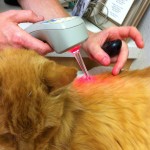 Pump, my second patient from Season 3 of Animal Planet's My Cat From Hell, receives a combination of needle and laser acupuncture treatment.
Recently, petMD asked me to contribute to a series of helpful tips for pet owners interested in applying acupressure techniques to their canine and feline companions. The tips are presented as a slideshow with photos of some of my patients receiving needle, laser, and moxibustion treatment: Acupuncture for Dogs and Cats.
Here is the slideshow's summary should you choose to not view it in the above link:
Pump, my second patient from Season 3 of Animal Planet's My Cat From Hell, receives a combination of needle and laser acupuncture treatment.
Recently, petMD asked me to contribute to a series of helpful tips for pet owners interested in applying acupressure techniques to their canine and feline companions. The tips are presented as a slideshow with photos of some of my patients receiving needle, laser, and moxibustion treatment: Acupuncture for Dogs and Cats.
Here is the slideshow's summary should you choose to not view it in the above link:
Dr Mahaney Gives Pet Owners Tips on How to Perform Canine and Feline Acupressure
Dr Mahaney Gives Pet Owners Tips on How to Perform Canine and Feline Acupressure
